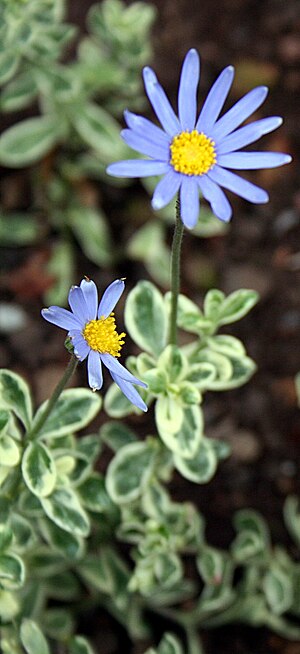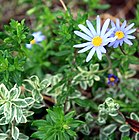Note: This is a project under development. The articles on this wiki are just being initiated and broadly incomplete. You can Help creating new pages.
Difference between revisions of "Felicia amelloides - Kasni"
m (Prabhakar moved page Kasni to Kasni (Felicia amelloides)) |
|||
| (22 intermediate revisions by 2 users not shown) | |||
| Line 1: | Line 1: | ||
| − | [[File: | + | [[File:Botanischer Garten Funchal - Felicia amelloides IMG 1767.JPG|thumb|right]] |
| + | '''Felicia daisy''' is a bushy, South African native valued for its bright masses of miniature blooms. Felicia daisy flowers consist of showy, sky blue petals and bright yellow centers. Butterflies are attracted to the vivid blue blooms. | ||
| + | ==Uses== | ||
| + | {{Uses|Indigestion}}, {{Uses|Worm burdens}}, {{Uses|Constipation}}, {{Uses|Bowel function}}, {{Uses|Skin eruptions}}. | ||
| − | + | ==Parts Used== | |
| + | {{Parts Used|Dried folaige}}, {{Parts Used|Whole herb}}. | ||
| − | == | + | ==Chemical Composition== |
| − | + | Coumarins, Cardiac Glycosides, Essential oils, Flavonoids, Phenolics, Saponins, and Steroids. However, Alkaloids, Anthraquinones, and terennins were not detected<ref name="chemical composition"/> | |
| − | |||
| − | == | + | ==Common names== |
| + | {{Common names|kn=Chikory|ml=Chikkari|sa=Kasni|ta=|te=Kasini, Kasini vittulu|hi=Kasni, Hinduba|en=Kasni}} | ||
| − | + | ==Properties== | |
| − | + | Reference: Dravya - Substance, Rasa - Taste, Guna - Qualities, Veerya - Potency, Vipaka - Post-digesion effect, Karma - Pharmacological activity, Prabhava - Therepeutics. | |
| − | + | ===Dravya=== | |
| − | |||
| − | == | + | ===Rasa=== |
| + | Tikta (Bitter) | ||
| + | ===Guna=== | ||
| + | Laghu (Light), Ruksha (Dry) | ||
| + | ===Veerya=== | ||
| + | Ushna (Hot) | ||
| + | ===Vipaka=== | ||
| + | Katu (Pungent) | ||
| + | ===Karma=== | ||
| + | Kapha, Pitta | ||
| + | ===Prabhava=== | ||
| − | + | ==Habit== | |
| − | + | {{Habit|Succulent}} | |
| − | |||
| − | == | + | ==Identification== |
| − | + | ===Leaf=== | |
| − | + | {{Leaf|Simple||The leaves are dark green above and light green below}}<ref name="Leaf"/> | |
| − | <ref name=" | + | |
| − | < | + | ===Flower=== |
| − | <ref name=" | + | {{Flower|Unisexual|3 cm|Bright yellow|5-20|Unlike many other members of the daisy family, the flowerheads of F. amelloides do not close at night}} |
| − | + | ||
| + | ===Fruit=== | ||
| + | {{Fruit||7–10 mm (0.28–0.4 in.) long pome|Each fruit is shed with its pappus which, acting like a tiny parachute, helps to disperse them|The cypselas (fruits) are dark brown with tiny hairs|}} | ||
| + | |||
| + | ===Other features=== | ||
| + | |||
| + | ==List of Ayurvedic medicine in which the herb is used== | ||
| + | * [[Vishatinduka Taila]] as ''root juice extract'' | ||
| + | |||
| + | ==Where to get the saplings== | ||
| + | ==Mode of Propagation== | ||
| + | {{Propagation|Seeds}}, {{Propagation|Cuttings}}. | ||
| + | |||
| + | ==How to plant/cultivate== | ||
| + | Drought-resistant and wind-resistant this plant thrives in a poor, well-drained soil so long as there is full sun and no damp<ref name="How to plant/cultivate"/> | ||
| + | |||
| + | ==Commonly seen growing in areas== | ||
| + | {{Commonly seen|Tall grasslands}}, {{Commonly seen|meadows}}, {{Commonly seen|Borders of forests and fields}}. | ||
| + | |||
| + | ==Photo Gallery== | ||
| + | <gallery class="left" caption="" widths="140px" heights="140px"> | ||
| + | Botanischer Garten Funchal - Felicia amelloides IMG 1767.JPG|Flowers | ||
| + | Botanischer Garten Funchal - Felicia amelloides IMG 1788.JPG|Flower | ||
| + | Felicia amelloides - Jardin des Plantes de Paris.JPG|At field | ||
| + | Felicia amelloides - San Luis Obispo Botanical Garden - DSC05904.JPG|Field | ||
| + | Felicia amelloides 04.JPG|Flowers | ||
| + | Felicia amelloides 2 RBGK.JPG|Flower | ||
| + | </gallery> | ||
| + | |||
| + | ==References== | ||
| + | |||
| + | <references> | ||
| + | <ref name="chemical composition">[https://www.ncbi.nlm.nih.gov/pubmed/22536286 Chemistry]</ref> | ||
| − | = | + | <ref name="Leaf">[http://powo.science.kew.org/taxon/urn:lsid:ipni.org:names:207656-1 General description]</ref> |
| − | + | <ref name="How to plant/cultivate">[https://www.rhs.org.uk/Plants/94694/Felicia-amelloides-Santa-Anita/Details How to grow]</ref> | |
| + | </references> | ||
| + | ==External Links== | ||
| + | * [http://www.missouribotanicalgarden.org/PlantFinder/PlantFinderDetails.aspx?kempercode=b724 Felicia amelloides on missouribotanicalgarden] | ||
| + | * [https://www.backyardgardener.com/plantname/felicia-amelloides-blue-marguerite/ Felicia amelloides on backyard gardener] | ||
| + | * [http://www.flowersofindia.net/catalog/slides/Chicory.html Felicia amelloides-flowers of india] | ||
[[Category:Herbs]] | [[Category:Herbs]] | ||
| + | [[Category:Asteraceae]] | ||
Latest revision as of 17:56, 6 May 2020
Felicia daisy is a bushy, South African native valued for its bright masses of miniature blooms. Felicia daisy flowers consist of showy, sky blue petals and bright yellow centers. Butterflies are attracted to the vivid blue blooms.
Contents
- 1 Uses
- 2 Parts Used
- 3 Chemical Composition
- 4 Common names
- 5 Properties
- 6 Habit
- 7 Identification
- 8 List of Ayurvedic medicine in which the herb is used
- 9 Where to get the saplings
- 10 Mode of Propagation
- 11 How to plant/cultivate
- 12 Commonly seen growing in areas
- 13 Photo Gallery
- 14 References
- 15 External Links
Uses
Indigestion, Worm burdens, Constipation, Bowel function, Skin eruptions.
Parts Used
Chemical Composition
Coumarins, Cardiac Glycosides, Essential oils, Flavonoids, Phenolics, Saponins, and Steroids. However, Alkaloids, Anthraquinones, and terennins were not detected[1]
Common names
| Language | Common name |
|---|---|
| Kannada | Chikory |
| Hindi | Kasni, Hinduba |
| Malayalam | Chikkari |
| Tamil | |
| Telugu | Kasini, Kasini vittulu |
| Marathi | NA |
| Gujarathi | NA |
| Punjabi | NA |
| Kashmiri | NA |
| Sanskrit | Kasni |
| English | Kasni |
Properties
Reference: Dravya - Substance, Rasa - Taste, Guna - Qualities, Veerya - Potency, Vipaka - Post-digesion effect, Karma - Pharmacological activity, Prabhava - Therepeutics.
Dravya
Rasa
Tikta (Bitter)
Guna
Laghu (Light), Ruksha (Dry)
Veerya
Ushna (Hot)
Vipaka
Katu (Pungent)
Karma
Kapha, Pitta
Prabhava
Habit
Identification
Leaf
| Kind | Shape | Feature |
|---|---|---|
| Simple | The leaves are dark green above and light green below |
Flower
| Type | Size | Color and composition | Stamen | More information |
|---|---|---|---|---|
| Unisexual | 3 cm | Bright yellow | 5-20 | Unlike many other members of the daisy family, the flowerheads of F. amelloides do not close at night |
Fruit
| Type | Size | Mass | Appearance | Seeds | More information |
|---|---|---|---|---|---|
| 7–10 mm (0.28–0.4 in.) long pome | Each fruit is shed with its pappus which, acting like a tiny parachute, helps to disperse them | The cypselas (fruits) are dark brown with tiny hairs | {{{6}}} |
Other features
List of Ayurvedic medicine in which the herb is used
- Vishatinduka Taila as root juice extract
Where to get the saplings
Mode of Propagation
How to plant/cultivate
Drought-resistant and wind-resistant this plant thrives in a poor, well-drained soil so long as there is full sun and no damp[3]
Commonly seen growing in areas
Tall grasslands, meadows, Borders of forests and fields.
Photo Gallery
References
External Links
- Ayurvedic Herbs known to be helpful to treat Indigestion
- Ayurvedic Herbs known to be helpful to treat Worm burdens
- Ayurvedic Herbs known to be helpful to treat Constipation
- Ayurvedic Herbs known to be helpful to treat Bowel function
- Ayurvedic Herbs known to be helpful to treat Skin eruptions
- Herbs with Dried folaige used in medicine
- Herbs with Whole herb used in medicine
- Herbs with common name in Kannada
- Herbs with common name in Hindi
- Herbs with common name in Malayalam
- Herbs with common name in Telugu
- Herbs with common name in Sanskrit
- Herbs with common name in English
- Habit - Succulent
- Index of Plants which can be propagated by Seeds
- Index of Plants which can be propagated by Cuttings
- Herbs that are commonly seen in the region of Tall grasslands
- Herbs that are commonly seen in the region of meadows
- Herbs that are commonly seen in the region of Borders of forests and fields
- Herbs
- Asteraceae






